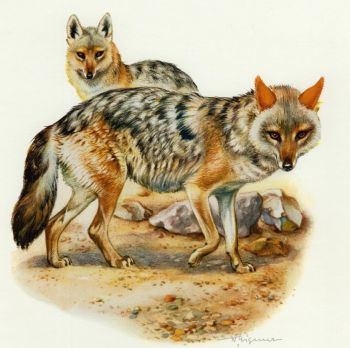Difference between revisions of "Golden Jackal"
Tao alexis (talk | contribs) |
Tao alexis (talk | contribs) |
||
| Line 15: | Line 15: | ||
| hpdie = d3 | | hpdie = d3 | ||
| attack = '''1''': [[Fangs (attack)|fangs]] | | attack = '''1''': [[Fangs (attack)|fangs]] | ||
| − | | dmg = 1–4 | + | | dmg = 1–4 (fangs) |
| special = none | | special = none | ||
}} | }} | ||
| − | + | '''Golden jackals''' are wolf-like [[Mammals (sage study)|mammals]] inhabiting regions spanning from the Balkans to Southeast Asia. Compared to the larger grey wolves, jackals are smaller, with shorter legs, tails, elongated torsos and narrower, pointed muzzles. Their coat exhibits color variations, from pale creamy yellow in summer to dark tawny beige in winter. | |
| + | |||
| + | [[File:Golden Jackal.jpg|left|350px|thumb]] | ||
| + | |||
| + | |||
| + | |||
| + | is a wolf-like that is native from the Balkans to Southeast Asia. The smallest of the grey wolves, the jackal is smaller and possesses shorter legs, a shorter tail, a more enlongated torso and a narrower and more pointed muzzle. Its coat varies in colour from a pale creamy yellow in summer to dark tawny beige in winter. They are abundant along rivers, canals, lakes and seashores, and avoid foothills and mountainous areas. They form families, with a breeding pair and young occupying areas where there are few or no wolves. | ||
| − | |||
They have no special attacks. As pests, they often raid camps for food, and can be heard howling in the night. This sound is often mistaken for wolves by those who are unfamiliar with the difference. They have been known to join wolf packs, scavenging off wolf kills without encountering hostility from the wolves. In some instances in India, lone jackals have formed relationships with tigers, feeding on the big cat's kills. These jackals will warn the tiger of coming danger. | They have no special attacks. As pests, they often raid camps for food, and can be heard howling in the night. This sound is often mistaken for wolves by those who are unfamiliar with the difference. They have been known to join wolf packs, scavenging off wolf kills without encountering hostility from the wolves. In some instances in India, lone jackals have formed relationships with tigers, feeding on the big cat's kills. These jackals will warn the tiger of coming danger. | ||
See [[Bestiary]] | See [[Bestiary]] | ||
Revision as of 23:18, 7 October 2023
| Species | canine |
| No. Appearing | 3–6 |
| Behaviour | social (family) |
| Range | barrens, desert, rainforest, savanna, steppe, woodland |
| Size | 30 in. long |
| Weight | 28 lbs. |
| Intelligence | 3 |
| Armour Class | 7 |
| Hit Dice | 1 |
| Action Points | 5 |
| Max. Stride | 9 |
| THAC0 | 20 |
| Hp/Die | d3 |
| Attack Forms | 1: fangs |
| Damage | 1–4 (fangs) |
| Special Attacks | none |
Golden jackals are wolf-like mammals inhabiting regions spanning from the Balkans to Southeast Asia. Compared to the larger grey wolves, jackals are smaller, with shorter legs, tails, elongated torsos and narrower, pointed muzzles. Their coat exhibits color variations, from pale creamy yellow in summer to dark tawny beige in winter.
is a wolf-like that is native from the Balkans to Southeast Asia. The smallest of the grey wolves, the jackal is smaller and possesses shorter legs, a shorter tail, a more enlongated torso and a narrower and more pointed muzzle. Its coat varies in colour from a pale creamy yellow in summer to dark tawny beige in winter. They are abundant along rivers, canals, lakes and seashores, and avoid foothills and mountainous areas. They form families, with a breeding pair and young occupying areas where there are few or no wolves.
They have no special attacks. As pests, they often raid camps for food, and can be heard howling in the night. This sound is often mistaken for wolves by those who are unfamiliar with the difference. They have been known to join wolf packs, scavenging off wolf kills without encountering hostility from the wolves. In some instances in India, lone jackals have formed relationships with tigers, feeding on the big cat's kills. These jackals will warn the tiger of coming danger.
See Bestiary
